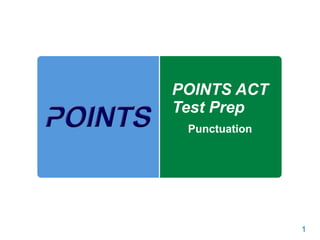This document provides instruction on punctuation rules for the ACT, focusing on the proper use of commas. It discusses the six primary uses of commas on the ACT: 1) to separate independent clauses joined by a conjunction, 2) to separate items in a series, 3) to separate two or more nonessential adjectives, 4) to set off dependent clauses at the beginning of a sentence, 5) to set off introductory phrases, and 6) to set off nonessential phrases, appositives, and transitional adverbs. For each use of commas, it provides definitions, examples, and explanations of when a comma is necessary or not necessary. It also includes practice questions related to comma usage.































































































